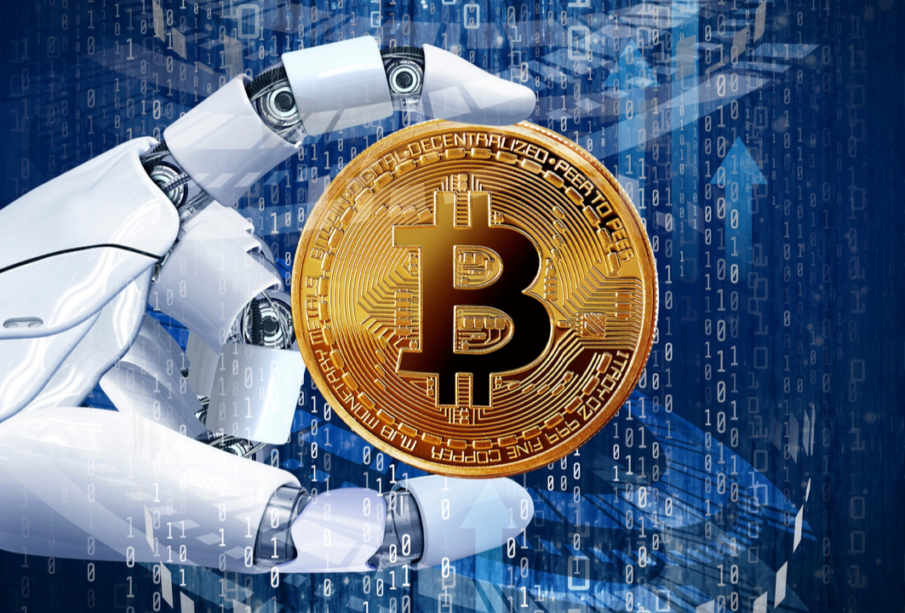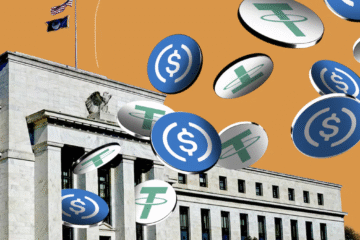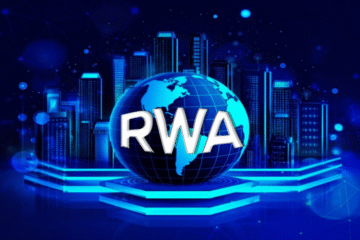AI and Crypto: Unlocking a $20 Trillion Market

The Convergence of AI and Crypto

AI and cryptocurrency are transformative forces, each reshaping industries in unique ways. AI, with a $450 billion market in 2025, enhances productivity through intelligent automation, while cryptocurrency, part of a $3.2 trillion crypto market, redefines trust and ownership via decentralization. Their intersection is projected to add $20 trillion to global GDP by 2030, per Bitwise, surpassing PwC’s estimates of $15.7 trillion for AI and $1.8 trillion for crypto due to synergistic effects.
This potential stems from addressing mutual challenges:
-
AI’s Needs: Scalable compute, secure data, and transparent models.
-
Crypto’s Needs: Enhanced analytics, user-friendly interfaces, and robust security.
-
Synergies: Decentralized compute, blockchain-based verification, and AI-driven smart contract automation.
Bitcoin Mining and AI: A Strategic Partnership
The Compute Crisis
The AI boom, fueled by NVIDIA’s $3.5 trillion valuation in 2025, has created an unprecedented demand for compute resources. Training large language models (LLMs) like GPT-5 requires tens of thousands of GPUs (e.g., 30,000 A100s for ChatGPT), while inference tasks demand scalable infrastructure. Data centers are stretched thin, with 83% of new capacity pre-leased, per CBRE Group. The Big Four cloud providers (Amazon, Google, Meta, Microsoft) plan $200 billion in 2025 data center investments, yet supply lags.
Bitcoin Miners as AI Enablers
Bitcoin miners, equipped with high-performance GPUs, advanced cooling systems, and access to power (54.5% sustainable, per industry reports), are uniquely positioned to bridge this gap. Their infrastructure, designed for data-intensive proof-of-work, aligns with AI’s high-performance computing (HPC) needs.
-
CoreWeave-Core Scientific Deal: In 2024, CoreWeave, an NVIDIA-backed AI cloud provider valued at $23 billion, signed a $3.5 billion, 12-year deal to host AI services in Core Scientific’s data centers, generating $290 million annually. This expanded to a $6.7 billion deal for 382 MW of HPC infrastructure by 2026, with CoreWeave funding retrofits. Core Scientific’s stock surged 140% in 2024 post-bankruptcy, reflecting market confidence.
-
Other Players: Hut 8 raised $150 million for AI data centers, Iris Energy projects $14–17 million in AI cloud revenue, and Galaxy Digital leased 133 MW to CoreWeave for $4.5 billion over 15 years.
-
Infrastructure Synergies: Miners’ access to power and fiber lines reduces HPC capex ($8–10M/MW for data centers vs. $300–800K/MW for mining, per Needham). However, ASICs (mining-specific chips) can’t run AI tasks, requiring GPU retrofits.
Economic Impact
This partnership diversifies miners’ revenue amid Bitcoin’s volatility (e.g., post-2024 halving, mining rewards dropped to 3.125 BTC/block). Core Scientific mined 411 BTC in July 2024 but expects stabler cash flows from AI hosting. By 2030, miners could capture 10% of the $500 billion AI compute market, contributing $50 billion annually to GDP.
Challenges
-
Retrofitting Costs: HPC data centers require custom infrastructure, unlike mining rigs. CoreWeave funds Core Scientific’s upgrades, but smaller miners may struggle.
-
Power Constraints: Data centers may consume 9% of U.S. electricity by 2030, up from 4% in 2023. Nuclear energy (used by TeraWulf) is a solution, but scaling is slow.
-
Competition: Cloud giants like AWS could undercut prices, though niche players like CoreWeave maintain 70% gross margins by leasing facilities.
Broader AI-Crypto Synergies
Beyond mining, AI and crypto intersect in transformative ways, amplifying their $20 trillion potential.
Information Validation
AI-generated content, like deepfakes, poses risks—labeled a top global threat by the World Economic Forum in 2024. Public blockchains offer transparent, immutable ledgers to counter misinformation.
-
Attestiv: Creates digital “fingerprints” for videos based on metadata (e.g., timestamp, location), stored on blockchains. Platforms can verify authenticity, flagging manipulations. This could extend to research, government communications, and NFTs, with a $100 billion market by 2030.
-
Impact: Enhances trust in digital media, critical as 25% of U.S. workers use AI weekly, per Goldman Sachs. Blockchain verification could add $500 billion to GDP by ensuring data integrity.
Virtual Assistants with Smart Contracts
AI assistants (e.g., Siri, Alexa) handle basic tasks but lack autonomy for complex transactions. Pairing them with smart contracts and cryptocurrencies (Bitcoin, stablecoins) enables secure, trustless automation.
-
Use Case: An AI assistant could book flights, execute payments via stablecoins, and record agreements on Ethereum, all without intermediaries. Fetch.ai’s autonomous agents already facilitate such tasks, with $50M TVL in 2025.
-
Impact: Boosts productivity in DeFi, e-commerce, and DAOs, potentially adding $1 trillion to GDP by streamlining $10 trillion in global transactions.
AI-Driven Crypto Platforms
AI enhances crypto ecosystems through analytics, security, and UX:
-
The Graph: Indexes blockchain data for Ethereum apps, with $2B market cap.
-
SingularityNET: A decentralized AI marketplace, enabling model sharing.
-
Ocean Protocol: Facilitates secure data sharing for AI, with $200M TVL.
-
Security: AI audits (e.g., 0x0.ai) reduce smart contract losses ($3.7B in 2024, per Chainalysis).
-
Impact: These platforms could capture 5% of the $2.8T crypto market, adding $140B to GDP.
Grayscale’s AI Crypto Sector
In May 2025, Grayscale established an “AI Crypto Sector,” classifying 20 tokens (e.g., Bittensor, Render, Akash) with a $21B market cap, up 366% from $4.5B in Q1 2023. Subcategories include AI platforms (Bittensor), tools (Render), and applications (Grass). This institutional recognition signals growing investor confidence.
Challenges to the $20 Trillion Vision
-
Technical Barriers:
-
Compute: Decentralized networks (e.g., io.net) excel in inference but struggle with LLM training due to latency and bandwidth constraints. Centralized clusters remain dominant.
-
Scalability: Public blockchains like Ethereum face data retrieval delays, limiting AI integration.
-
-
Regulatory Risks:
-
Tokenized platforms risk SEC scrutiny as securities. GDPR/HIPAA compliance is critical for AI data applications.
-
Crypto volatility (e.g., Solana’s 20% spike in March 2025) impacts project stability.
-
-
Security Concerns:
-
AI-powered phishing scams cost $400M in 2023. GPT-4 exploits 87% of smart contract vulnerabilities, necessitating robust defenses.
-
-
Hype vs. Substance:
-
Many AI-crypto projects lack deep integration, using AI as a marketing ploy. Sustainable tokenomics are critical to avoid speculative bubbles.
-
Strategic Path to $20 Trillion
To realize this potential:
-
Infrastructure Investment: Miners must scale GPU retrofits, leveraging nuclear and renewable energy. CoreWeave’s $9B data center commitment sets a benchmark.
-
Innovation: Projects like Bittensor and Ocean Protocol should deepen AI-blockchain integration, focusing on ZKML and on-chain AI execution.
-
Regulation: Clear frameworks for tokens and data privacy will unlock institutional capital.
-
Adoption: AI-driven UX (e.g., The Graph, Kaito) can onboard millions, pushing Web3’s daily users past 100M by 2027.
Economic Breakdown:
-
Compute Partnerships: $1T (miners, cloud providers).
-
Verification Systems: $2T (Attestiv-like solutions).
-
Smart Contract Automation: $5T (virtual assistants, DeFi).
-
AI Crypto Platforms: $2T (data, analytics, security).
-
Synergistic Effects: $10T (cross-industry adoption).
Conclusion
The AI-crypto nexus, exemplified by Bitcoin mining-AI partnerships like CoreWeave-Core Scientific, is a cornerstone of a $20 trillion market. Miners’ pivot to AI hosting addresses compute shortages, while blockchain verification (Attestiv) and smart contract assistants (Fetch.ai) tackle misinformation and inefficiency. Grayscale’s AI Crypto Sector underscores institutional momentum, with $21B in token value.
However, technical, regulatory, and security challenges demand rigorous innovation. The $20 trillion projection hinges on deep integration, not hype. By 2030, AI and crypto could redefine trust, productivity, and economic value, but only if stakeholders prioritize substance over speculation. For investors, focus on projects with robust fundamentals (e.g., Bittensor, Ocean). For developers, build interoperable, user-centric solutions. The path is complex, but the potential is profound.










